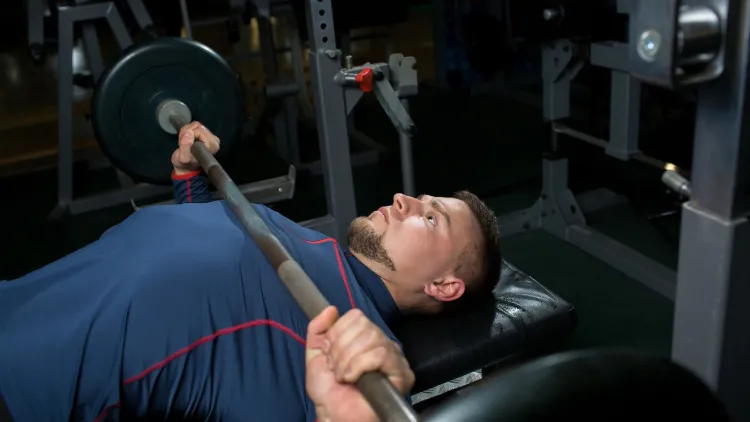Bench press is an old-fashioned upper-body strength training type of exercise which develops the muscles of the chest, shoulders, and triceps. It is famous for enhancing posture, power, and athletic performance. Since it is used by professional athletes and those who prefer to work out, it is something that everyone includes to check their strength and improve themselves. Be it the correct form, record lifts, or even its impact on fitness, the bench press is an age-old exercise that is used to shape the concept of strength training.
What is the Bench Press?
The bench press is a compound resistance stationary activity which involves mental pressure of a weighted dumbbell or a barbell of a stiffened up ahead of the chest with the supine body mass resting on a flat bench. It mainly focuses on the pectoralis major, anterior deltoids and triceps brachii. Since it has the ability of training many muscles simultaneously, the bench press contributes to the overall upper-body strength and size.
Due to its effectiveness, this exercise is common in gyms, athletic programs, as well as professional sports training programs. It is classified as one of the three major lifts that include squats and deadlifts, which are used in the determination of overall body strength.

How the Bench Press Works
The bench press has various advantages other than building muscles. It develops upper body pushing strength, increases bone density and makes the shoulders more stable. The aesthetic of the body and sports abilities is enhanced by having a wide chest and strong arms through continuous training.
The bench press is also found to increase functional strength in the fitness field. The compulsive movement resembles daily activities, like pushing things or maintaining a posture. In the long run, this practice helps in enhancing greater body alignment, balance, and endurance.
Of interest, several women also employ the bench press as an exercise method of enhancing tone in the upper body. As opposed to the myth, pressing does not shrink or enlarge breasts; instead, it develops the pectoral muscles beneath them that have the potential to make the chest region firmer and lifted.
Proper Form and Technique
To execute the bench press safely and efficiently, do the following steps:
- Position: From the lying position, facing the bar, with your eyes directly lower than the bar. Hold the bar in a gripped position with a width slightly greater than the shoulders.
- Posture: Place all your feet on the floor, core taut and your shoulder blades in, to cushion your shoulders.
- Lowering: It is recommended to lower the bar slowly and then touch it barely enough, mid-chest.
- Pressing: Flex the bar straight as one exhales, with wrists straight and elbows at 45 degrees.
Strict form guarantees that the muscles are maximally engaged and no strain takes place in the shoulders. Stability and power output are also enhanced by the use of appropriate breathing patterns.

Muscle Groups Targeted
The bench press makes use of a variety of large muscles that are located in the upper parts of the body:
- Pectoralis Major: This is the primary muscle of the chest that is used to push the bar up.
- Triceps Brachii: Pulls the arms in a push-up.
- Anterior Deltoids: Help to move and stabilise the shoulder.
- Core and Serratus Anterior: Keep the posture and containment during the up-lift.
This combination qualifies it as a basic movement towards creating a well-rounded, strong physique.
How Much Bench Pressing?
The strength of the bench press depends on body weight and experience, and training consistency. A typical beginner man may be able to bench 50-60 kg at 70 kg, and an intermediate lifter would be able to bench 80-100 kg. High-performance athletes usually press over 120kg, based on their workouts and body size.
The bench press capacity to lift 100 kg and above is considered one of these landmarks of gym culture. The critical point is progressive overload, though, increasing the weight gradually as the muscles grow accustomed to it, not lifting too heavy at first.
Records, Legends, and Lifting Feats
The bench press, over the years, has been a venue where a great display of strength is given. And it is a real power gauge—fewer than 1 per cent. The world can bench press 225 pounds (or approximately 102kg) with ease.
The Bench press records are some of the highest, with Jimmy Kolb being the first man to bench even above 1,000 pounds (around 455 kg), and this is the limit in human performance. In professional sports, there are well-known cases of NFL players such as Larry Allen doing 43 reps of 225 pounds, which shows tremendous strength of extreme endurance.
Tom Brady, on the other hand, who was skilled as a quarterback and not necessarily strong, reportedly in his youth bench pressed around 315 pounds. An example of a hero of strength and discipline, Dwayne, otherwise known as The Rock, has been quoted as pushing 400-450 pounds during his best training years. During his Rocky days, Sylvester Stallone was supposed to have been able to bench up to 385 pounds or so, which is quite a feat on his frame.

Bench Press on the NFL and Sports
The bench press is an important part of the NFL combine, during which players are not only tested in terms of their number-of-times-whereas-pressing 225 pounds, but also in terms of their character and ability to work well with others (i.e. their interpersonal skills). It is an exercise of strength and endurance of the arm muscles. Athletes such as DK Metcalf recorded 27 reps, whereas Rob Gronkowski (Gronk) recorded 23 reps.
Interestingly enough, Tim Tebow left scouts impressed with 22 reps of 225 pounds, and Tom Brady allegedly had several reps at the start of his career, but then paid more attention to the flexibility training.
Comparing speed and strength of athletes, DK Metcalf is considered to have an unparalleled sprint speed, and Tyreek Hill is a bit faster and more agile. It is demonstrated that power and speed may be used together in the performance of elite athletes.
The Training Strategy and 3-3-3 Rule
There is a common 3-3-3 rule among lots of lifters; that is, 3 sets of 3 reps, as well as a strength-building phase. The focus of this method is on reps that are few and heavy to build nerve muscle power and neuronal efficiency. It is especially applicable to those whose goal is to increase their maximum on the bench press with time.
This rule can be combined with the accessory exercises, organising a synergetic impact of triceps dips, shoulder presses, and dumbbell flyes and provide the optimal muscle development and avoid plateaus.
Celebrity Bench Press Stats and Fun Facts
The bench press has been used since time immemorial to give strength to legends and Hollywood icons:
- Bruce Lee was able to bench approximately 115 pounds, considering his body weight and the emphasis he put on martial arts and not bodybuilding.
- The maximum size that Tom Brady would bench was 315 pounds.
- Dwayne Johnson is said to have increased his weight to 450 pounds, showing his dedication to weight training.
- One of the legends who continues to surprise the fans is Larry Allen, who does 43 reps of 225 pounds.
- NFL player DK Metcalf was a powerful player with speed, which he demonstrated in his bench work as well as being a world-class sprint athlete.
- The most official raw bench press that has ever taken place is the 1,005-pound bench press by Jimmy Kolb, which showed just how far man can extend his power.
These statistics bring to light the large difference in the level of strength in different athletes and occupations – bodybuilders, martial artists, and football players.

Different variations of the Bench Press
Lifters usually adjust the bench press in order to achieve various angles of the muscles.
The most efficient ones have been:
- Incline Bench Press: Also works on the upper chest and shoulders.
- Decline Bench Press: This involves the lower region of the chest.
- Close-Grip Bench Press: Strengthens the triceps.
- Dumbbell Bench Press: Strengthens balance and coordination.
- Reverse-Grip Bench Press: The emphasis is on the upper chest.
The variations included make training balanced, prevent the overuse of injuries, and provide the overall development of the muscles.
Safety and Spotting
In the bench press, it is crucial to be safe. It is always good to include light sets before trying the heavy lifts. And another so that when you are under your limit, you should have someone to help you, a spotter, one who can help you should the bar grow too heavy.
When training all by yourself, use a power rack with safety bars. Do not bang the bar on your chest or hump your back too high. The form will not only defend you but also help you to establish consistent progress.
The Bench Press in modern fitness
The bench press in the contemporary fitness scene has been an iconic power and endurance test. It makes people feel confident, encourages lifters to get better, and is an excellent indicator of improvement. Through regular training, good nutrition, and rest, the lifters would slowly be able to develop larger bench figures and build a massive, muscular upper body.
Whether it is Hollywood personalities such as Stallone or even the sports players such as Gronk, the bench press links generations of those who want to feel stronger. It is not merely bar lifting but rather about discipline, building up, and control, one of the most basic exercises in strength training.

Final Thoughts
The bench press is the final icon of strength of the upper body. It makes the chest, shoulders and arms strong, increases stability, posture, and muscle tone. Patience and consistency are the key factors in achieving a goal, not just with 50 kg or even with 200 kg chasing records.
Having correct form, intelligent progression and effort, anyone can reach a better bench press position. It is one of the most fitting, enduring exercises that brings together athletes and fitness lovers with legends in the quest for power.
Frequently Asked Questions
1. Does bench press make one stronger?
Yes, it helps to strengthen the upper body, working on the chest, shoulders, and triceps.
2. What is the amount of bench press that beginners should do?
Begin with 50 -60 kg, and add it gradually as your strength grows.
3. Does bench press alter the shape of the chest?
It enhances breast muscle and makes them stronger, making them look firmer without actually having any changes in the size of the breast.
4. What’s a good bench press goal?
The target of bench-pressing 100 kg is a good aim, work on the safe and consistent growth.







